Unexplored Places in Jaipur
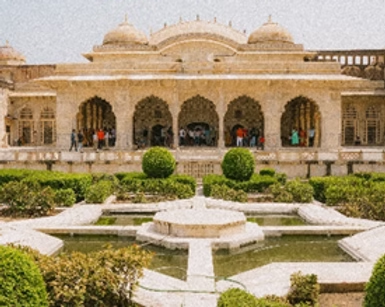
Rajasthan’s main city, Jaipur, is a kaleidoscope of hues, culture, and history. The Pink City is a popular tourist destination because of its majestic forts, palaces, and lively markets. However, hidden gems and less travelled areas that provide a glimpse into another side of Jaipur’s appeal can be found below the beaten roads. We’ll delve deeper into Jaipur’s historical centre during this extended trip to find the lesser-known treasures that are frequently hidden in the shadows of their more well-known equivalents. Sisodia Rani Ka Bagh: A Royal Retreat In the midst of the Aravalli Hills’ luxuriant vegetation, Sisodia Rani Ka Bagh emerges as a tranquil haven away from the bustling city. This beautiful garden, created in 1728 by Maharaja Sawai Jai Singh II in memory of his queen Sisodia Rani, is a tribute to their unending love. The layout of the garden is made up of a number of terraces, each of which has colourful murals depicting stories from Krishna’s life. The delicate design skillfully combines Rajput and Mughal influences to create a charming sanctuary that is frequently overshadowed by the larger monuments of the city. The air is filled with the scent of blooming flowers as you stroll along the shaded pathways, creating a magical atmosphere. The terrain is punctuated by pavilions and fountains, providing idyllic locations for reflection. The garden is a must-visit for anyone looking for a more sedate, private glimpse into Jaipur’s past because of its tranquil beauty, which is a monument to the beautiful history it possesses. Credit: Unsplash Galta Ji Temple: The Monkey Temple A haven of peace and spirituality, Galta Ji Temple is located outside the city’s busy streets. This structure, also known as the Monkey Temple, is situated in the Aravalli Hills and is a refuge for both pilgrims and outdoor enthusiasts. The temple is made up of various water tanks and shrines, each of which has a special history and significance. The natural spring that supplies the tanks at Galta Ji Temple and flows into a series of pools where worshippers bathe in holy water is the temple’s main attraction. The temple, which is surrounded by rocky hills, emanates a tranquil aura in contrast to the bustle of the city. You’ll experience a connection with Jaipur’s spiritual core that surpasses its more well-known attractions as you stroll through the courtyards and engage with the local monkeys. Credit: Unsplash Panna Meena Ka Kund: Architectural Elegance Panna Meena Ka Kund, a hidden gem next to the Amer Fort, is a prime example of Jaipur’s architectural excellence. Indian architecture is characterised by stepwells, and this particular stepwell is a masterpiece that is frequently overlooked by uninformed visitors. The symmetrical placement of the steps and arches produces a captivating visual effect that exemplifies the period’s exquisite craftsmanship. You’ll feel awe and wonder when you walk down the steps and into the well. The architecture is given a dramatic touch by the interaction of light and shadow, which is a photographer’s dream. Panna Meena Ka Kund is a poignant example of how Jaipur’s lesser-known sites also have a unique appeal that adds to the city’s architectural legacy. Credit: Unsplash Jawahar Circle Garden: Tranquil Oasis Jawahar Circle Garden provides a haven from the bustle of city life among the urban sprawl. One of the largest circular gardens in Asia, it is surrounded by lush meadows, colourful flowers, and a tranquil atmosphere that invites guests to relax and refuel. The expansive rose garden, which features a variety of vibrant flowers and fills the air with a subtle smell, is what makes this garden unique. A large marble sculpture that serves as the garden’s focal point is a representation of peace and unity. The outside world seems to vanish as you wander gently or find a peaceful place to sit, leaving behind a serenity and time for reflection. In the midst of the grandeur of nature, the Jawahar Circle Garden invites you to experience the simplest joys of life. Credit: Unsplash Chandlai Lake: Avian Paradise At Chandlai Lake, a sanctuary not far from Jaipur, nature lovers and birdwatchers are in for a treat. The lake, which is surrounded by hills and peace, transforms into a thriving ecology in the winter when migratory birds make it their temporary home. The magnificent surroundings are like a painting that has been painted in the hues of avian life. The lake serves as a haven for a variety of bird species, including playful ducks, regal herons, and graceful cranes. Birds flying gracefully over the water and the calming sounds of nature will meet you as you stroll along the shoreline. Credit: Unsplash Conclusion: Unveiling Jaipur’s Treasures Jaipur has a plethora of undiscovered jewels that are just waiting to be discovered outside the pages of travel books and tourist brochures. These undiscovered areas, whether they be tranquil gardens, magnificent buildings, or natural sanctuaries, give Jaipur’s cultural fabric more depth and character. A new type of appeal can be found in the city’s quieter areas, one that speaks of intimacy, spirituality, and the enduring bond between people and environment. While the Jal Mahal and City Palace shine brightly, they are not the only attractions there. You’ll develop a special link with the city as you explore these lesser-known locations; this bond will go beyond the surface and dive into the city’s more personal tales. These uncharted locales beckon you to set out on a journey of discovery and immerse yourself in the untold stories that Jaipur has to offer, from the romantic allure of Sisodia Rani Ka Bagh to the spiritual serenity of Galta Ji Temple, the architectural masterpiece of Panna Meena Ka Kund to the peaceful respite of Jawahar Circle Garden, and the avian paradise of Chandlai Lake.
Exploring the Mountains: A Guide to the Main Attractions Along the Shimla-Manali Highway
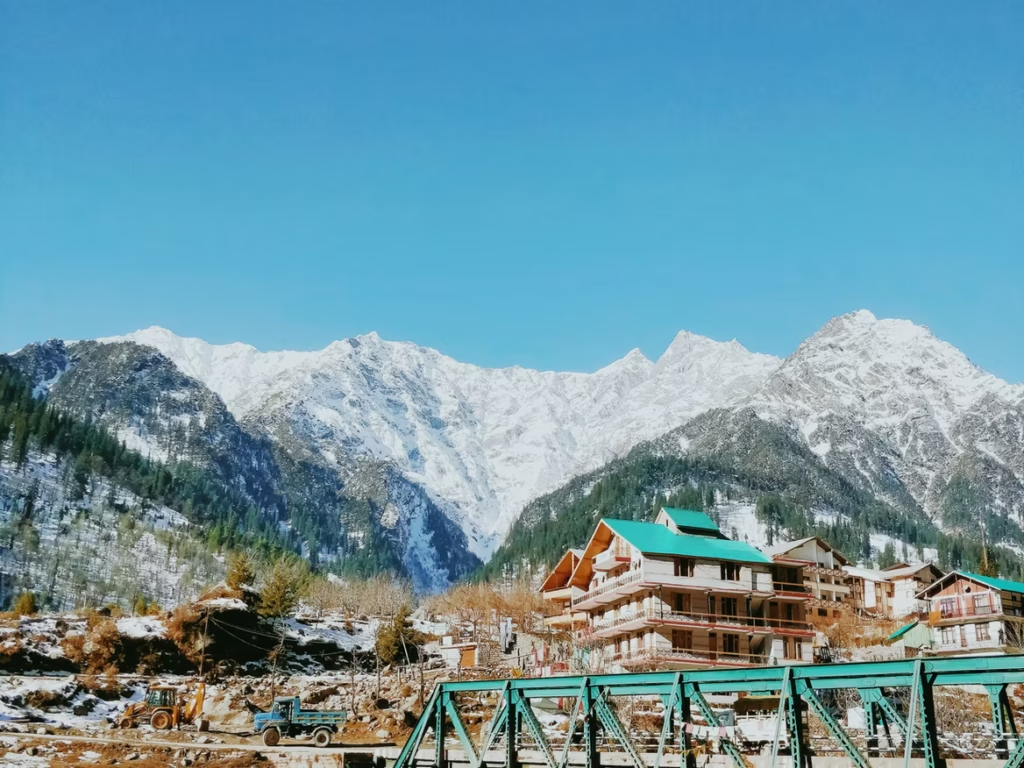
Winding paths framed by tall snow-capped peaks, scattered colorful villages and charming cafes with hot piping momos – the scenic Shimla to Manali highway is a road tripper’s paradise. This northern mountain route offers non-stop enchanting vistas of the Himalayan foothills, with ample pitstops to experience the local cultures along the way. Covering a distance of about 240 kms, the 5-6 hours drive is best enjoyed over 2-3 days for comprehensive exploration. The cool breezy hill towns of Shimla and Manali serve as idyllic basecamps, surrounded by outdoor adventures, spiritual sites, colonial architecture and abundant nature. This guide takes you through the main attractions spanning this route, promising stunning landscapes, adrenaline rush inducing activities and delicious food discoveries around every turn! Scenic beauty of Manali (Source: Unsplash) Shimla and Nearby Attractions Nestled amidst lush green hills, Shimla is the perfect starting point to kickstart your road trip adventure. Take a stroll down the bustling Mall Road, lined with restaurants, shops and historic buildings. Stop by the towering Christ Church and charming Gaiety Theatre dating back to the British Raj era. The majestic Jakhu Temple, perched atop the highest peak in Shimla, offers panoramic views of the Shivalik ranges. Be sure to also ride the narrow-gauge Kalka-Shimla Toy Train for an unforgettable journey from Kalka to Shimla through mountain tunnels and forests. Just outside Shimla lie stunning natural wonders like Kufri, India’s popular skiing destination. Hike through Alpine meadows and forests here. Naldehra’s iconic golf course surrounded by deodar trees is another must-visit. For breathtaking views, head to Chail, known for its lush expanse of greenery. Shimla also makes for a great base to enjoy adventure activities like rafting, camping and mountain biking. Take a day trip to nearby Mashobra and enjoy picnic lunches by the river. With its old-world charm and natural splendor, Shimla is the perfect opening chapter to your road trip story. The real beauty of Shimla (Source: Unsplash) Journey from Shimla to Manal The drive from Shimla to Manali is universally renowned for its sensational mountain vistas. Curve around roads hugged by tall pine trees, with the Beas gushing alongside in many stretches. It’s recommended to cover the distance over 2 days, stopping overnight in the village of Naggar. Here, visit the ancient Naggar Castle with its unique stone and wood architecture. Further along, the bustling town of Kullu makes for an exciting pitstop. Try rafting in the Beas or hiking nearby places like Kasol. The scenic hamlet of Jibhi with its waterfalls and trout fishing spots is another great place for some quietude. Stop frequently along the route to photograph the mesmerizing landscapes. Closer to Manali, experience Manikaran Sahib’s hot springs or visit Naggar’s quaint Nicholas Roerich art gallery. The mountainous journey from Shimla to Manali is packed with rewarding detours. A small park in the town of Kullu (Source: Unsplash) Top Attractions in/near Manali Manali’s captivating natural beauty and vibrant culture make it a must-visit. To experience the best of this charming mountain town, there are some attractions you simply cannot miss. This section highlights the top must-visit places that will allow you to soak in Manali’s allure-: Hadimba Temple – Famed for its unique four-tiered pagoda-style architecture and dedicated to Hadimba Devi. The intricately carved walls and doorway are a must-see. Mall Road – Lively main street lined with colorful shops, restaurants and cafes. Perfect place for shopping, people-watching and trying local cuisine. Old Manali – Charming old village with cobbled paths across the Manalsu River. Offers great views, spiritual vibe and quaint cafes. Solang Valley – Picturesque valley perfect for adventure activities like paragliding and zorbing in summer and skiing in winter. Rohtang Pass – Located at an altitude of 3,978 m, it offers stunning views of the surrounding mountainscapes and glaciers. Requires a permit. Manu Temple – Dedicated to the sage Manu, it is located in Old Manali and is an important pilgrimage site. Nehru Kund – A natural spring named after Jawaharlal Nehru located on the way to Rohtang Pass near Manali. Hadimba Temple, an architectural masterpiece (Source: Unsplash) Where to stay and eat With its mist-laden hillsides and old-world charm, Manali attracts travelers seeking scenic views or adrenaline-filled adventures. While the sights and activities energize your days, Manali’s excellent accommodation options ensure you have the perfect place to relax and recharge at night. From cozy guesthouses with views of the Beas River to resorts tucked away in apple orchards, Manali’s hotels cater to all budgets and styles. The options range from backpacker dorms costing under ₹500/night to lavish 5-star properties exceeding ₹15,000/night during peak seasons. For a curated list of the 10 best hotels in Manali chosen for their amenities, value and ambience, check out our previous blog post here. The list covers options in Old Manali, Mall Road, Manali town center and outskirts – so you can conveniently choose a base to match your itinerary. This is how Manali looks in the night (Source: Unsplash) An unforgettable experience The Shimla-Manali route promises an epic mountain adventure. Pack smart, make scenic playlists, and get ready to create magical memories. Follow this guide to the main attractions and experiences. Let the spectacular Himalayan terrain enchant you as you road trip through some of North India’s most majestic vistas and charming towns. You can also check out our free AI travel planning itinerary here to better organize you future trips. Free AI Travel Planner
Top Budget Hotels in Manali for a Mountain Getaway
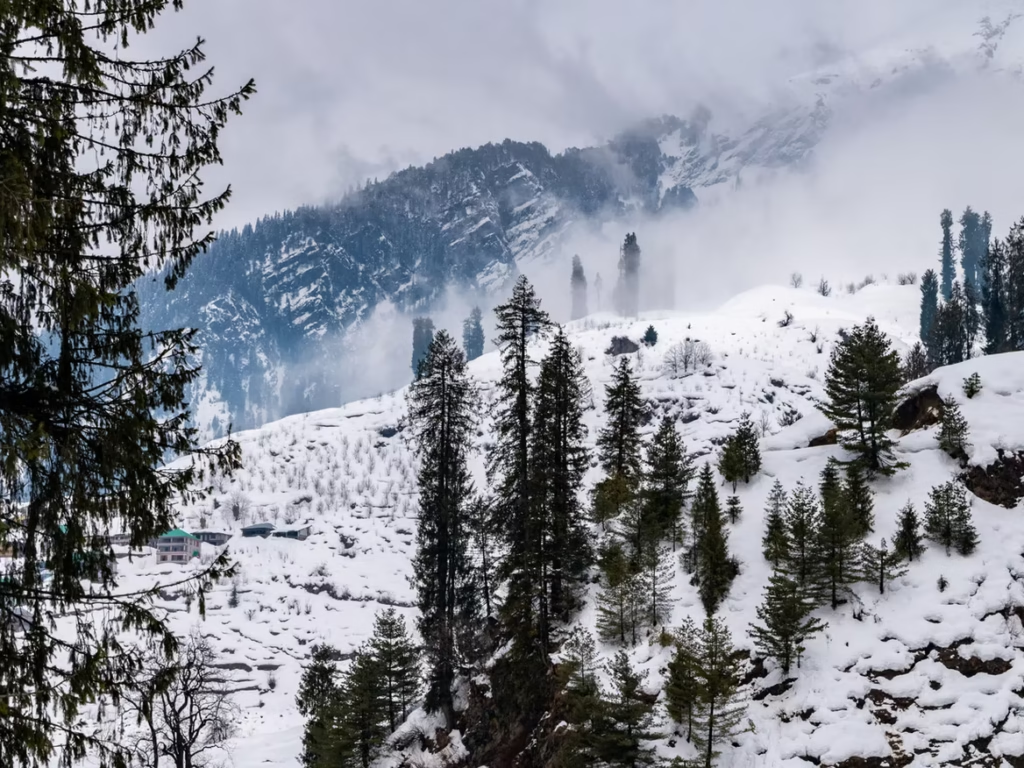
Manali is one of the most idyllic hill stations in India and a haven for budget travellers. Surrounded by snow-capped peaks, lush green forests, and the Beas River winding through the valley, Manali’s natural beauty is unparalleled. A snowy landscape with scarce vegetation (Source: canva) From adrenaline-pumping adventure activities like paragliding and rafting to serene treks to ancient temples, Manali has something for everyone. While accommodations can be expensive, there are many excellent budget hotel options to enjoy Manali without burning a hole in your wallet. In this blog post, I recommend the top 5 budget hotels in Manali for an affordable mountain vacation. Whether you’re a backpacker, solo traveller, couple, or family, you will find suitable lodging that fits your budget. I have handpicked these hotels based on location, amenities, reviews, and value-for-money. The Orchard Greens Hotel View of the Orchard Greens Hotel (Source: theorchardgreens.com) Conveniently located next to Mall Road, The Orchard Greens Hotel offers budget rooms starting Rs.1360 per night. It is walking distance from top attractions like Hadimba Temple and Manu Temple. Compact yet comfortable rooms have amenities like free Wi-Fi, room service, LCD TVs, attached bathrooms and mountain views. The warm staff and in-house restaurant serving delicious meals enhance your stay. Make use of the fitness center or get sightseeing assistance at the travel desk. Panoramic views of Manali can be enjoyed from the rooftop. The central location, essential amenities and close proximity to main town make it ideal for solo travelers, couples and small families wanting a value for money hotel in the heart of Manali. Hotel Snow Valley Resort An insider view of the Hotel Snow Valley Resort (Source: booking.com) Escape the bustle of Manali by staying at Hotel Snow Valley Resort, nestled amidst verdant gardens in tranquil Old Manali. Starting at Rs. 1500 per night, spacious rooms with modern amenities exude rustic mountain charm. Floor-to-ceiling windows showcase sweeping valley vistas while you wake up to bird songs every morning. Focused on rejuvenation, the resort offers yoga sessions, relaxing massages and day excursions. Savor delicious vegetarian fare at the restaurant after working up an appetite on nature walks. Adventure seekers try paragliding flights and river rafting nearby. Shuttle service provides easy transfers to Mall Road. Snow Valley Resort’s serene setting, indulgent amenities and warm hospitality make it a wonderful retreat for families and couples seeking quality time in nature’s lap away from Manali’s crowds, yet close enough to town. Zostel Manali View of Zostel Manali in the evening (Source: zostel.com) Zostel Manali is every backpacker’s paradise, located close to Mall Road with beds starting at just Rs. 500 per night in dorm rooms. The lively hostel brims with young travelers from around the world bonding over free Wi-Fi, books, board games and cafe chatter. Daily activities like paragliding, village walks and karaoke nights promise non-stop fun. Whip up free home-cooked meals in the common kitchen and swap travel stories at the terrace cafe. Clean and colorful dorms allow budget travelers to save money for adventure sports. Zostel’s sociable ambience, basic comforts and wallet-friendly rates make it the ultimate hangout for solo travelers and groups wishing to meet like-minded people while enjoying Manali’s attractions on a shoestring budget. If you are considering Zostel Manali as your perfect stay destination, we have some good news for you. The hotel is located in multiple destinations throughout the city. Here is a list of all of them- Zostel Manali (Old Manali) Zostel Manali (Vashisht) Zostel Manali (Burwa) Zostel Homes Pangan (Manali) Zostel Dhobi Hotel Tibetan Classic A representative image of Hotel Tibetan Classic (Source: canva) Escape the tourist crowds by staying at Hotel Tibetan Classic in laidback Vashisht village, with traditionally decorated rooms from Rs. 1500 per night. Intricate woodwork, plush fabrics and Buddhist murals transport you to Tibetan culture. Start your day with hot Butter Tea while soaking up mountain views from the garden cafe. Wind down with a traditional Thai massage or peek into astrology sessions at the in-house wellness center. The multi-cuisine restaurant serves flavorful Tibetan momos and thukpas. Hotel Tibetan Classic’s charming Ladakhi-style architecture, spiritual ambience and tranquil village location make it perfect for couples and families wanting to experience the Buddhist side of Manali. The friendly staff and cultural immersion opportunities add to its allure. Johnson Lodge Manali A view of the Johnson Lodge Manali in the morning (Source: tripadvisor) Located in the heart of Manali near Mall Road, Johnson Lodge is a value for money stay with spotless rooms starting Rs. 1000 per night. The lodge greets you with a bright yellow exterior and a beautiful garden. Airy rooms with tasteful wooded interiors provide a comfortable retreat after a long day of sightseeing. Guests appreciate the friendly staff, complimentary breakfast, Wi-Fi access and amenities like room service, safety locker and laundry. The in-house restaurant serves delicious Indian and continental fare. Johnson Lodge’s central location, budget-friendly rates and warm hospitality make it a convenient choice for couples and solo travelers who want to stay near Manali’s main hub without spending too much. Unwind in comfort knowing all attractions are a quick stroll away. For information about the best time to visit Manali, you can read this blog. If you want to learn more about which destinations to visit in Manali you can check out our AI itinerary planner below which can provide a list of the must visit destinations in Manali, as per your travel preference and budget. Free AI Travel Planner
The Ultimate Manali Travel Guide: How to reach and get around the mountain town.
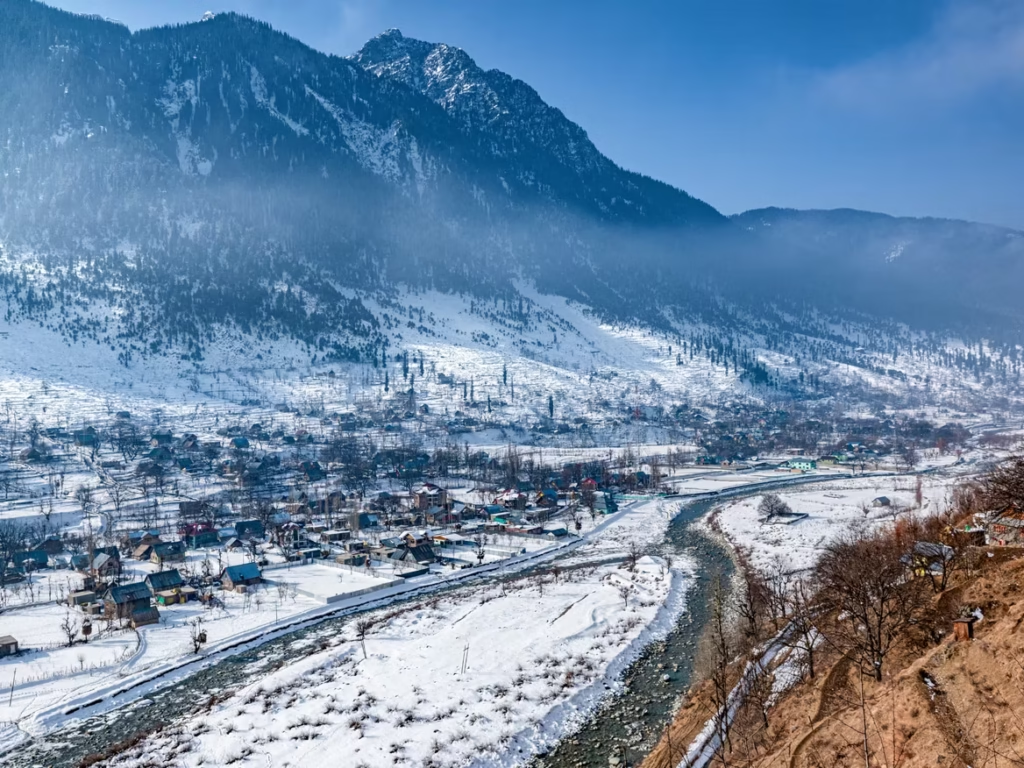
Situated high up in the Himalayas, Manali has rightfully earned its reputation as one of India’s top tourist destinations. Framed by snow-capped peaks and boasting lush green forests, this quaint mountain town promises postcard-perfect views at every turn. From adventures like rafting and skiing to cultural treasures like ancient temples, Manali attracts travelers seeking both adrenaline rush and serenity. The laidback cafes, Tibetan monasteries, and local handicraft shopping beckon as well. Regardless of whether you seek nature’s embrace or prefer soaking in history, Manali delivers ample opportunities. Its cool and pleasant climate during summer provides welcome respite from India’s sweltering heat. Reaching this mountain gem is easy, and getting around quite hassle-free. This guide will equip you to plan an immersive trip to Manali. The astounding beauty of Manali during the Winters (Source: canva) Arriving in Manali: Journey to the Mountains Manali is well connected to the other parts of India through air, road and rail. You can reach the hill station through the following methods: By Air The nearest airport is Bhuntar Airport located around 50km from Manali in the Kullu district. It has regular flights from Delhi, Chandigarh, Shimla and other major cities by airlines like Air India, IndiGo, SpiceJet, etc. Taxis charge about ₹2000 to reach Manali from the airport. One can also take a bus which costs around ₹200 per person. By Rail The closest major railway station is Joginder Nagar railway station, approximately 165km from Manali. It falls on the Pathankot–Jogindernagar narrow gauge railway line. The train route is incredibly scenic but takes around 10 hours from Pathankot. From Joginder Nagar you can hire a taxi or take a Himachal Road Transport Corporation (HRTC) bus to cover the 6 hour onward journey to Manali. By Road The most popular way to get to Manali is by road. National Highway 21 connects Manali to Chandigarh and further to other major cities. The highway is well maintained with scenic views throughout. Luxury Volvo buses by HRTC provide a comfortable overnight journey from Delhi, taking about 14 hours. You can also hire a private taxi or self-drive your own car on this route. Zigzag roads win you over with mountain vistas. Stopovers in towns like Karnal and Bilaspur can break the trip. If you want to plan a road trip from Delhi-Manali, read this blog. Train taking a sharp turn on a mountainous bridge (Source: canva) Day Trips from Manali: Nearby Gems to Explore With its location in the hills, Manali serves as an ideal base to explore scenic destinations nearby. Some recommended day trips are: Rohtang Pass Located 51 km from Manali, the high mountain pass of Rohtang lies at an altitude of 3978 m. Visit to see snow even in summers and gorgeous views. Requires permit. Solang Valley Just 13 km from Manali, Solang is renowned for adventure sports like paragliding, zorbing and skiing. During summer you can hike here or picnic by the river. Naggar Village This quaint village 20 km from Manali has European style castle, temples, museums and art galleries to explore on a day trip. Manikaran The religous town of Manikaran located 45 km from Manali attracts pilgrims to its hot springs and beautiful Sikh gurudwara. With so much natural beauty around, taking day trips from Manali allows you to make the most of your time there. Follow the tips above for memorable short excursions. Morning View of Manikaran across the shore (Source: canva) Manali awaits! With its idyllic setting amidst snow-clad mountains and spiritual aura, Manali casts a spell on all who visit. Reaching this Himachal town is easy by air, road and rail. Navigating within Manali can be done conveniently by buses, rental vehicles, bicycles or on foot. The destinations near Manali like Rohtang Pass and Solang Valley promise adventure and stunning vistas. Take scenic day trips and partake in activities like paragliding for once-in-a-lifetime experiences. From ancient temples to gushing rivers, Manali is a gateway to some of India’s most prized natural wonders. You can also check out this free AI planner travel to better plan your trips as per you desirable preferences and budget constraints. Free AI Travel Planner
Andaman & Nicobar Islands
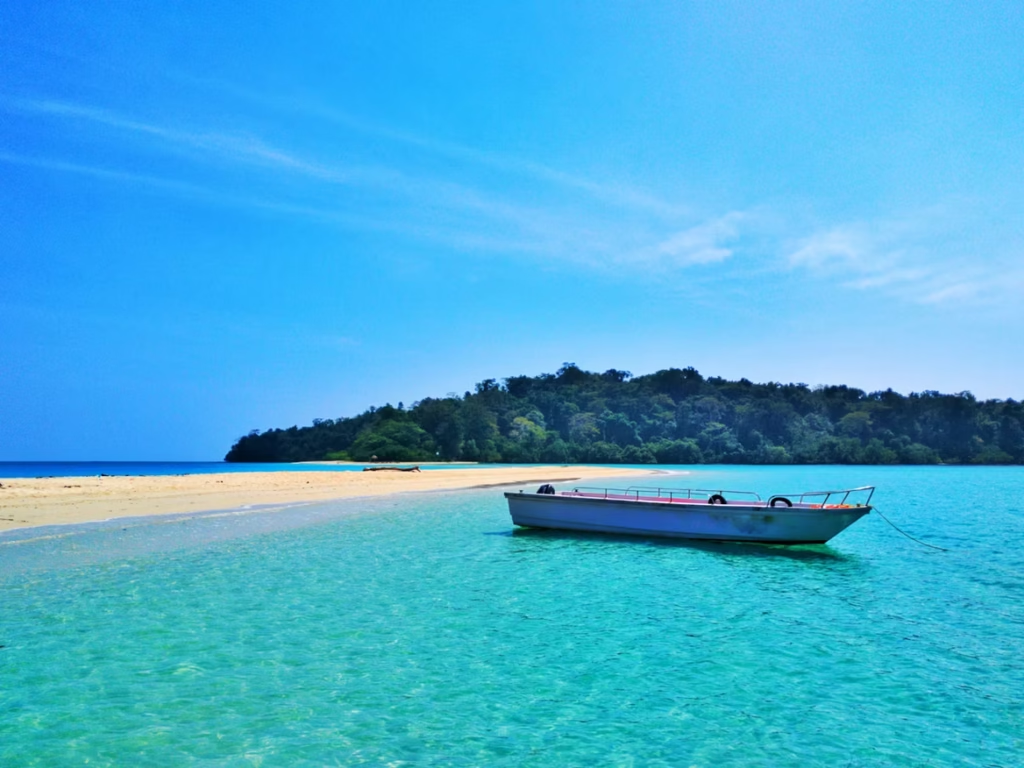
An Idyllic Paradise in the Bay of Bengal About History Population and people Climate Top 3 places to visit About The Andaman and Nicobar islands are one of the 8 union territories of India and are located in the Bay of Bengal, located between latitudes 6°N and 14°N and longitudes 92°E and 94°E. One can find white sand, pristine beaches lined with palm trees all over the islands. They give an opportunity for the perfect getaway to an abundance of quiet, tranquillity, and turquoise water. Andaman is a living example of what you mean when you refer to a “Tropical Paradise.” History The English East India Company’s fleet reached the Andaman Islands in 1789, and the British connected them administratively to the Nicobar Islands in 1872. The Andaman Islands are located on the historic trade route between India and Myanmar. In 1956, the two groups of islands were admitted as a union territory of the Indian Republic. The region has been known for its indigenous communities, which have steadfastly avoided considerable engagement with ethnic outsiders, for more than a century. The islands gained international prominence in 2004 after a sizable tsunami that had been caused by an earthquake in the Indian Ocean close to Indonesia badly destroyed them. 8,249 square km or 3,185 square miles. Population and People Photo by bionic__exe on Unsplash South Asian immigrants and their offspring make up the great bulk of the Andamans’ population. The majority of people speak Hindi or Bengali, but Tamil, Telugu, and Malayalam are also widely used. In the past, the Andamanese were small, isolated communities. Single outrigger canoes were used to harpoon or net turtles, dugongs, and fish. Major cultural change wasn’t possible until the middle of the 20th century due to the isolation of the Andamanese and their overall antagonism toward Westerners. Few native Andamanese remain alive today; the majority of these populations were wiped out by disease as a result of their contact with Europeans, Indians, and other foreigners. Early in the twenty-first century, the majority of the Nicobar Islands’ population was still made up of its native Nicobarese people (including the related Shompen). Both the Mon (also known as the Talaing) of Myanmar and the Malays of insular and peninsular Southeast Asia are likely their direct ancestors. The Austroasiatic language family includes the Mon-Khmer language group, which includes the Nicobarese languages. Some Nicobarese also speak Hindi and English. The Nicobar Islands are home to a sizable Tamil community in addition to its native inhabitants and other residents from the Indian mainland. As part of the Indian government’s initiative to advance the region’s agriculture, many arrived during the 1960s and 1970s. The people of the Andaman and Nicobar Islands are friendly and proud of their rich cultural history. Their welcoming atmosphere and open spirit provide visitors to the islands a sense of belonging. Festivals and events highlight the variety of their cultures while also encouraging unity among the diverse ethnic populations. The islanders have a deep connection to nature, living in harmony with the beautiful surroundings and enthusiastically sharing their knowledge of the indigenous flora and animals. Their fortitude in the face of adversity, especially natural calamities, is inspiring, and they continue to prosper with a strong sense of community. Interacting with the inhabitants exposes their true warmth and openness, leaving lasting recollections of the island’s allure. The inhabitants of the Andaman and Nicobar Islands are an essential part of the enthralling experience, making your trip genuinely enriching. Take advantage of the opportunity to engage with these friendly hosts and learn about the distinct character that defines this tropical sanctuary. Climate The best thing about these islands is that they are a year-round vacation spot with little variation in temperature and constant comfort. Between October and May is regarded as the ideal season to visit the Andaman and Nicobar Islands. A tropical paradise with a year-round warm and humid environment, the weather is sunny and comfortable, ideal for beach activities, snorkelling, and discovering beautiful coral reefs. The turquoise sea and moderate breeze provide an excellent environment for water sports and underwater experiences. During the monsoon season, which lasts from May to October, rain showers renew the lush green forests, creating a peaceful haven for nature enthusiasts but it is not a good time to visit because of the high tides, persistent rain, and strong winds. Regardless of the weather, immerse yourself in the islands’ rich cultural heritage by attending local events and traditional performances. Whether you prefer sun-kissed beaches or lush rainforests, the Andaman & Nicobar Islands provide a memorable and diverse experience, attracting travellers with their spectacular beauty and kind welcome. Because Andaman is a tropical island, it never experiences winter. Tourists can simply relax and take in the expansive view of the ocean in this comfortable, moderately humid climate that gives a good sea breeze. In the summer, the white dunes contrast with the clear blue sky and turquoise sea, which reflect blue tones. This makes for a beautiful vacation spot, not just for honeymooning couples but also for families with older members. It’s the ideal location to get a drink and relax on the shacks because it’s not too hot or humid. Andaman and Nicobar Airports How were Andaman and Nicobar Islands formed? Are Andaman and Nicobar Coral Islands? The Andaman and Nicobar Railways Do you need a passport to travel to Andaman and Nicobar Islands? Top 3 places to visit for your next trip to Andaman and Nicobar Islands Port Blair Photo by Sahil on Unsplash The Andaman and Nicobar Islands’ capital is Port Blair. Additionally, it serves as the sole notified town in the region as well as the administrative centre for the South Andaman district and the local administrative subdivision (tehsil) of the islands. The entry point is Port Blair, which has both air and marine connections to the rest of India. INS Jarawa, a
Albania’s Albanian Riviera: Sun, Sea, and Untouched Beauty
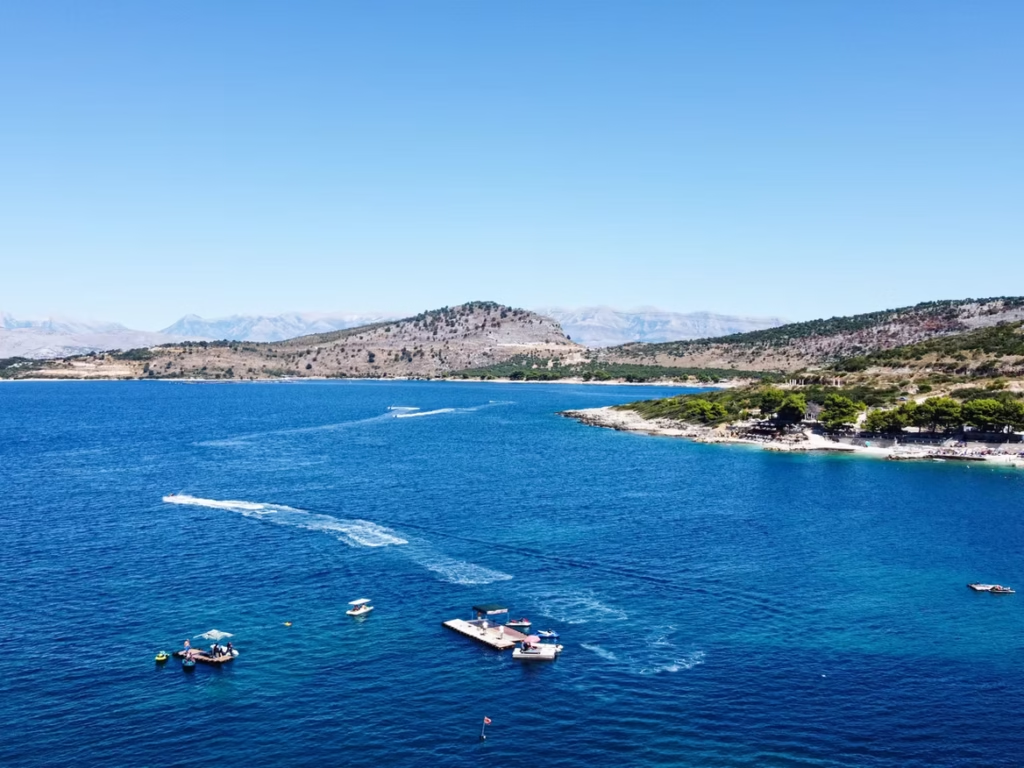
Tucked away along the Adriatic Sea, you’ll find a hidden holiday gem – the Albanian Riviera. Situated away from the tourist hordes, this sun-soaked coastline entices with aquamarine waters, pristine beaches stretching as far as the eye can see, and lovely limestone cliffs plunging into the sea. Sip espresso at beachside cafes under 150-year-old olive trees, swim among the caves and coves, and hike trails that wind past sleepy villages seemingly untouched by time. That’s just a part of what this little-known slice of Mediterranean paradise offers you. Serene beauty of a Mediterranean Beach (Photo by Bleron on Unsplash) Here is how to experience the pristine glory of Albanian Riviera- 1. Gjipe Beach Aerial view of a crowded beach alongside blue waters (Photo by Renaldo on Unsplash) The word “Gjipe” is derived from the Albanian word for “peace”. As its name suggests, arrive early in the morning to experience Gjipe’s tranquility all to yourself. Nestled at the end of a steep cliffside trail, Gjipe Beach is a hidden gem along the Albanian Riviera. With vistas that look airbrushed and serenity unmatched by larger beaches, Gjipe offers an unspoiled Mediterranean escape. Its remoteness provides a calming reprieve from modern life’s busyness. 2. Ancient Dhermi Huge mountains of Dhermi stretched across (Photo by Sara on Unsplash) In Dhermi, you can uncover ancient ruins and natural beauty in just one charming destination. The most taken route is to hike to the 6th century Monastery of St. Theodore and 4th century BC fortresses for insights into medieval history amidst mountain-top views. Afterwards, descend to Dhermi’s pristine beach, renowned as one of Albania’s most beautiful, for a scenic Mediterranean escape. 3. Drymades Stone ruins of an ancient Greek amphitheater (Photo by Daria on Unsplash) When the sun goes down, Drymades Beach comes alive with lively beach parties, bonfires, and all-night dance clubs. Sip local raki cocktails, sway to modern and folk music under the stars, and meet fellow travelers late into the evening. This sandy shoreline transforms into the Riviera’s most vibrant nightlife destination. 4. Ksamil Islands Top-down view of Ksamil Islands with surrounding emerald green ocean (Photo by Altin on Unsplash) Off the coast of Sarandë lies the untouched beauty of Ksamil Islands, a small archipelago with three main islands – St. Nicholas, Basta, and Ksamil – connected by picturesque footbridges. The Ksamil Islands offer a perfect blend of nature, relaxation, delicious dining, and vibrant nightlife, while retaining a peaceful, remote island feel. This island paradise often remains unexplored and unknown by the tourists making it one of the most underrated destinations on the Riviera. So don’t you rather miss it out! 5. Llogara Pass Aerial view of roads stretching across miles of a green terrain (Photo by Elion on Unsplash) Llogara Pass, reaching 1,043 meters above the Albanian Riviera, offers spectacular views of the coastline and Ionian Sea. As you drive the scenic mountain road, you can stop at lookouts to see beaches unfolding below. One fun activity is to hike the fragrant pine forests and watch for golden eagles overhead. The Llogara mountain pass makes for a rejuvenating pitstop on this Albanian roadtrip. At last, there is also the Llogara National Park nearby which is rich in biodiversity having over 1,000 plant species and roaming wild horses.
Belgium’s Artistic Marvels: Exploring the Flemish Masters and Beyond
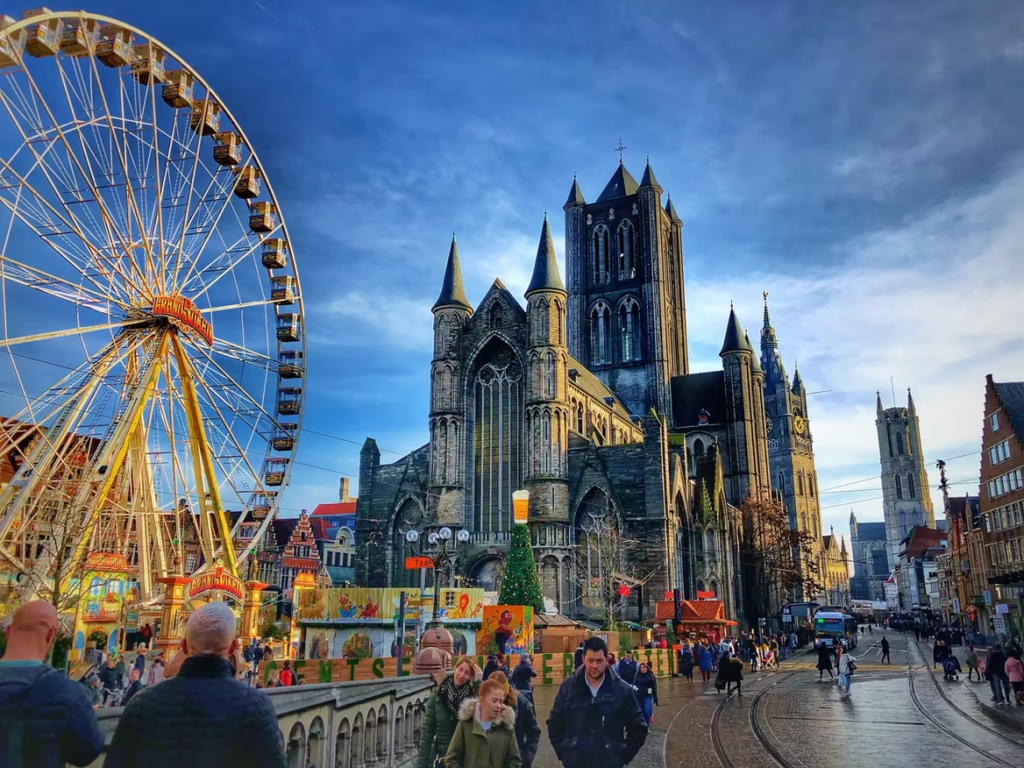
In the very heart of Western Europe rest a small but mighty land – Belgium. Though often overlooked on the crowded European map, this plucky country holds an embarrassment of artistic riches within its compact borders. Belgium is a country where the medieval melds seamlessly with the modern. Centuries-old cathedrals and guild houses brush up against contemporary art museums and sleek cafés. This fusion creates an energetic artistic spirit that permeates every city and town. An eclectic aesthetic where old and new are not only embraced, but celebrated. From the vibrant whirl of brushstrokes by Baroque masters to the soaring spires of Gothic grandeur, Belgium offers a bonanza of visual splendor awaiting discovery. Once you arrive here, one thing becomes clear – you don’t have to be big to make a mammoth artistic impact. Sometimes, the greatest creative wonders come in small packages. And this is what this small euro- nation proves this magnificently. A beautiful view of a Belgian city (Source: Unsplash) Now, sit back and relax while we take you across the top attractions in the country- Brussels A street full of people in Brussels (Source: Unsplash) Brussels remains one of Europe’s most enticing capitals for art and architecture devotees. The city brings Belgium’s finest structural designs together, from medieval guildhalls to Art Nouveau façades. The Grand Place exemplifies Brussels’ aesthetic appeal with Gothic towers and intricate baroque details adorning its historic central square. In Brussels you can stroll through ornate Art Nouveau neighborhoods to admire Victor Horta’s UNESCO-protected houses, including the magnificent Stoclet Palace. For an immersive overview, the CIVA Centre’s exhibits masterfully display eight centuries of Brussels’ architectural evolution. As a pilgrimage point for Art Nouveau, the city’s mansions, churches, and commercial buildings transform Brussels into a living museum of Belgian craftsmanship and style. Places to visit- Grand Place, Art Nouveau Neighborhoods, Victor Horta Houses, CIVA Centre Bruges Steep Sloped houses across a river in Bruges (Source: Unsplash) Romantic canals and medieval charm establish Bruges as one of Europe’s most picturesque art cities. Bruges brings the legacy of Belgian art to life with architecture spanning eight centuries. You can visit the egg-shaped Lake of Love for stunning views of the 13th century belfry towering over august buildings or the Groeningemuseum where 15th century Flemish Primitives take center stage, including Jan van Eyck’s “Madonna with Canon van der Paele.” Wander around beetling cobblestone lanes and discover almshouses, patrician residences, and hidden churches adorned with works by Bruges’ Flemish masters. For a quintessential Bruges experience, take a moonlit canal boat ride and enjoy the city’s twinkling architectural marvels, shaped by generations of artists’ brushstrokes. Places to visit- Lake of Love, Belfry Tower, Groeningemuseum Ghent A cathedral in Ghent (Source: Unsplash) With its medieval towers, guildhalls, and patrician mansions reflected in winding canals, Ghent encapsulates the splendor of historic Flemish cities. As one of the largest canal metropolises, Ghent intertwines art and architecture seamlessly. St. Bravo’s Cathedral safeguards the Ghent Altarpiece, featuring the Adoration of the Mystic Lamb, Jan van Eyck’s pioneering 15th century masterwork. Bask in the grandeur of Graslei’s guild houses along the Leie River or venture to the 1460 Belfry and its bell tower views rising above a labyrinth of architectural marvels below, Ghent is for you. From Romanesque to Renaissance to Gothic revival styles, the city exemplifies Belgium’s finest architectural achievements and the art it has inspired for centuries. Place to visit- St. Bravo’s Cathedral, Graslei, Belfry of Ghent, Gravensteen Castle Antwerp Aerial View of a huge building across a river (Source: Unsplash) As the center of baroque style, Antwerp indulges art lovers with Rubens’ lavish paintings around every corner. The ornate guildhouses and step-gabled warehouses lining the Scheldt River reflect the prospering port’s 16th century Golden Age. Make a pilgrimage to the Rubenshuis, the iconic painter’s home and studio, to view his epic works firsthand and lose yourself within Antwerp Cathedral, whose towering Gothic spire dominates the skyline, while interiors house art-adorned chapels and the impressive Raising of the Cross triptych. As the day winds down, join locals at a lively cafe along Grote Markt square, Antwerp’s radiant centerpiece, and toast to the city’s artistic heritage lasting through the centuries. Places to visit– Rubenshuis, Antwerp Cathedral, Grote Markt, Plantin-Moretus Museum Leuven Roadside view of a street in Leuven (Source: Unsplash) With its soaring late Gothic St. Peter’s Church rising above ornate Renaissance facades, Leuven reflects the rich artistic heritage of central Belgium. As the capital of the Brabant province, Leuven cultivated influential early Flemish painters like Rogier van der Weyden. Wander the historic center and encounter stately 15th century architecture, including elaborately carved medieval halls lining the Town Hall. When in Leuven make sure to visit the M Museum Leuven, home to the world’s most comprehensive collection of early Netherlandish masterpieces, including rare works by Robert Campin and Jan van Eyck. After admiring the city’s architectural gems, relax at a lively outdoor café on the Oude Markt, a square bustling with university culture and legacy. Leuven provides the perfect blend of medieval charm, Renaissance beauty, and lively modern energy. Places to visit– St. Peter’s Church, Leuven Town Hall, Groot Begijnhof, Park Abbey Mechelen Windy night on the streets of Mechelen (Source: Unsplash) Mechelen is a hidden gem overflowing with architectural splendor. While smaller than Bruges or Ghent, Belgium’s capital of culture punches above its weight class with artistic treasures. Gothic spires peek above candy-colored houses along tree-lined canals. The monumental City Hall lords over the central square, beckoning visitors inside to see its lavish interior and paintings. St. Rumbold’s soaring cathedral towers above all, its 556-foot spire climbing to the heavens. As day fades to night, witness Mechelen’s buildings glow under spotlights while strolling canal-side and listening to carillons ring out from church towers.
Top Attractions to Include in Your Goa Travel Itinerary

Goa’s allure as a popular tourist destination lies in its perfect amalgamation of stunning beaches, cultural heritage, adventurous water sports, and vibrant nightlife. It caters to the preferences of every traveler, be it a beach lover, an adventure seeker, a history enthusiast, or a party animal. With its welcoming locals, delectable cuisine, and a relaxed tropical vibe, Goa promises an unforgettable experience that will keep you longing for more. So, pack your bags, soak up the sun, and let Goa cast its spell on you. While spontaneity has its charm, planning a comprehensive travel itinerary is essential for a well-organized and enjoyable trip. It helps you optimize your time, secure reservations, manage your budget effectively, discover hidden gems, and prioritize your safety. So, whether you’re embarking on a solo adventure or traveling with companions, take the time to plan a detailed itinerary and watch as your travel experience becomes smoother, more fulfilling, and unforgettable. Goa, the pearl of the Indian coastline, is a traveler’s paradise that offers a diverse range of attractions. From its pristine beaches and colonial heritage to its vibrant markets and mouthwatering cuisine, Goa has something for every type of traveler. In this comprehensive travel itinerary, we will highlight the top attractions that should be included in your visit to Goa. Get ready to immerse yourself in the breathtaking beaches, explore the historical sites, savor the local flavors, and experience the unique charm of this tropical destination. Credit: Unsplash Beaches and Waterfront Delights Goa, the coastal haven of India, is synonymous with stunning beaches, thrilling water sports, and enchanting cruises. Every year, travelers flock to this tropical paradise to indulge in the perfect blend of relaxation and adventure. In this blog post, we will provide an introduction to renowned beaches in Goa, an overview of popular water sports available, and essential tips for selecting reliable cruise operators to maximize your experience. Here are few places and things you will love to visit or do in Goa. Credit: Unsplash Calangute Beach Known as the “Queen of Beaches,” Calangute Beach is a popular hotspot that offers a vibrant atmosphere, water sports, and beachside shacks serving lip-smacking seafood. This expansive stretch of golden sand attracts both domestic and international tourists. Baga Beach Adjacent to Calangute Beach, Baga Beach is famous for its energetic nightlife and beach parties. It offers a lively ambiance, water sports activities, and a wide array of beachside restaurants and bars. Anjuna Beach Anjuna Beach captivates visitors with its laid-back hippie vibes and stunning natural beauty. It is renowned for its Wednesday Flea Market, where you can find unique handicrafts, clothes, and souvenirs. Anjuna is also known for hosting full-moon beach parties. Parasailing Soar high above the azure waters of Goa and enjoy breath taking views of the coastline during a parasailing adventure. The experience of being lifted by a parachute while being towed by a speedboat is exhilarating and unforgettable. Snorkeling For those who prefer to stay closer to the water’s surface, snorkeling is an excellent option. Put on your snorkel mask and fins, and dive into the sea to discover colorful fish, coral gardens, and other fascinating marine species. Credit: Unsplash Historical and Cultural Marvels Goa’s historical forts, magnificent temples, majestic churches, and UNESCO World Heritage sites offer a glimpse into its rich cultural and architectural legacy. Exploring the iconic forts of Aguada and Chapora allows you to delve into the region’s historical defenses, while visiting prominent temples and churches provides a deeper understanding of Goa’s spiritual heritage. Lastly, wandering through the Latin Quarter and Fontainhas transports you back in time, immersing you in the colonial charm of Goa. Discover these historical gems and let Goa’s vibrant past unfold before your eyes, creating memories that will last a lifetime. Here are few places for you to visit in Goa. Credit: Unsplash Aguada Fort Aguada Fort, a magnificent 17th-century Portuguese fort, stands tall on the Sinquerim Beach in North Goa. Built as a defense against Dutch and Maratha invasions, the fort offers panoramic views of the Arabian Sea. Explore its massive walls, visit the lighthouse, and step into history as you admire the impressive architecture and soak in the breathtaking vistas. Chapora Fort Perched atop a hill overlooking the Chapora River, Chapora Fort holds a prominent place in Goa’s history and pop culture. Dating back to the 17th century, the fort offers mesmerizing views of the coastline. Immortalized in the Bollywood movie “Dil Chahta Hai,” the fort’s ruins and panoramic setting make it a favorite spot for sunset enthusiasts and history buffs. Basilica of Bom A UNESCO World Heritage site, the Basilica of Bom Jesus in Old Goa is a prominent Christian pilgrimage site. The church holds the mortal remains of St. Francis Xavier, a revered saint. Marvel at the Baroque architecture, intricate woodwork, and the awe-inspiring artistry inside the church. The Basilica is an emblem of Goa’s colonial legacy and an architectural masterpiece. Se Cathedral Adjacent to the Basilica of Bom Jesus, the Se Cathedral is the largest church in Asia dedicated to St. Catherine. This 16th-century church showcases Portuguese-Gothic architecture at its finest. Admire the ornate altars, exquisite artwork, and the magnificent Golden Bell, known for its rich tonal quality. The Se Cathedral is a symbol of Goa’s religious heritage and grandeur. Latin Quarter The Latin Quarter in Panaji, Goa’s capital city, is a vibrant neighborhood that takes you back in time to the Portuguese colonial era. The narrow winding streets, colorful houses, and architectural influences create an old-world charm. Stroll through the Fontainhas area, witness the vibrant colors of the buildings, and soak in the unique ambiance that earned it the title of a UNESCO World Heritage site. Fontainhas Fontainhas, a sub-district within the Latin Quarter, is renowned for its well-preserved Portuguese architecture. The neighborhood is home to charming heritage houses, art galleries, quaint cafes, and boutiques. Take a leisurely
Kerala Calling: Tips and Tricks for Planning Your Ultimate Kerala Trip

Welcome to Kerala, a charming state in southern India renowned for its verdant scenery, tranquil backwaters, stunning beaches, and rich cultural history. While organizing a trip to Kerala is thrilling, having a well-thought-out itinerary is essential because there is so much to see and do there. We’ll provide you helpful advice and pointers in this blog post so you can plan the perfect vacation to Kerala and make the most of your time there. If you’re looking for a destination that offers natural beauty, cultural richness, and unique experiences, look no further than Kerala. This south Indian state is a popular tourist destination that boasts of stunning backwaters, beautiful beaches, lush hill stations, wildlife sanctuaries, and historic sites. Kerala, often referred to as “God’s Own Country,” is a mesmerizing state located in the southern part of India. With its breathtaking landscapes, vibrant culture, rich history, and warm hospitality, Kerala has captivated the hearts of travellers from around the world. Credit: Unsplash Understanding Kerala Before planning your trip, it’s important to understand Kerala’s geography, climate, and seasons. Kerala is a narrow strip of land that lies between the Arabian Sea and the Western Ghats. The state has a tropical climate with two monsoon seasons – Southwest monsoon (June-September) and Northeast monsoon (October-December). Kerala’s key attractions include the backwaters, beaches, hill stations, wildlife sanctuaries, and historical sites. The state is also known for its cultural richness, including traditional art forms, festivals, and Ayurveda. Kerala is well known for its extravagant festivities and festivals that showcase its diverse cultural heritage. One of the most well-known festivals is Thrissur Pooram, which takes place at the Vadakkunnathan Temple and features stunning elephant procession displays, authentic percussion groups, and a mesmerising fireworks display. Another notable holiday is Onam, the harvest festival, which highlights Kerala’s rich cultural heritage with colourful floral arrangements, boat races, cultural performances, and the Onam Sadhya, a large feast. Kerala has become a pioneer in promoting ethical travel practises. The state promotes eco-friendly activities, community support, and environmental stewardship to visitors. Choose accommodations that put sustainability and conservation first. To help the community and learn more about Kerala’s culture and customs, choose local tour operators and craftsmen. Consider how your actions may affect the delicate ecosystems and indigenous peoples, and make an effort to leave a favourable trail after your stay. For tourists looking for a distinctive and enlightening experience, Kerala’s natural beauty, cultural legacy, and genuine hospitality make it a tempting destination. You may genuinely enjoy and embrace the delights that this state has to offer if you comprehend what Kerala is all about. Explore its stunning landscapes, savour its cuisine, and engage with its dynamic communities as you get immersed in its rich traditions. Making lifelong memories while exploring “God’s Own Country” will help you understand its essence. Credit: Unsplash Best Time to Visit The ideal time to visit Kerala is during the winter months of September to March. Kerala enjoys a good environment and beautiful weather with lower humidity during this time of year. Winter is the ideal season to visit Kerala’s beautiful towns to experience their magical lagoons, peaceful canals, and spicy plantations. Hill towns like Munnar and Wayanad are quite popular with tourists during Kerala’s summer months, which are April and May. The monsoon season, which lasts from June to August, is preferred by those seeking ayurvedic treatments. Generally speaking, the winter season, which lasts from September to March, is the greatest time to visit Kerala to take advantage of the stunning surroundings and comfortable climate. The months of November through February are the ideal ones to visit Kerala’s backwaters. Choosing Your Itinerary The captivating state of Kerala in southern India is a veritable treasure trove of scenic beauty, rich cultural history, and kind people. Kerala provides a wide range of experiences for every type of traveller, from calm backwaters to scenic hill towns and immaculate beaches. Now we’ll outline the Kerala attractions that should be on your schedule so you won’t miss out on the treasures that make this state so unique. Kochi (Cochin) The thriving port city of Kochi, which serves as the entrance to Kerala, skillfully combines tradition and innovation. Discover the historic Fort Kochi neighbourhood, which is noted for its colonial buildings, Chinese fishing nets, and mediaeval churches. To see the stunning murals, go to the well-known Mattancherry Palace, also called the Dutch Palace. Don’t miss the thriving Jew Town or the Paradesi Synagogue, one of the Commonwealth’s oldest still in use. Munnar Munnar, a charming hill station hidden within the Western Ghats’ undulating hills, is renowned for its verdant tea plantations, mist-shrouded valleys, and beautiful vistas. Visit the Tea Museum to learn about the art of brewing tea, tour the enormous tea farms, and enjoy in energising tea tasting sessions. Don’t forget to take a tranquil boat ride on Kundala Lake and take in the captivating views from well-known lookout sites like Top Station and Echo Point Alleppey (Alappuzha) Alleppey is a must-visit location in Kerala because of its backwaters and houseboat tours. Take a captivating houseboat tour through the serene backwaters, winding canals, and quaint towns. As you pass rice fields, coconut groves, and traditional wooden homes, take in the tranquilly of rural life in Kerala. Long snake boats compete in an exhilarating race in Alleppey’s annual Nehru Trophy Boat Race. Thekkady Thekkady, which is situated in the Periyar National Park, is a paradise for those who enjoy the outdoors and wildlife. To see herds of elephants, sambar deer, and many bird species, go on a boat safari on Periyar Lake. Explore spice plantations, trek through thick forests, and take in the area’s abundant biodiversity. Thekkady is renowned for its exceptional opportunity to witness the age-old martial art style known as Kalaripayattu. Kovalam Kovalam is the place to be if you’re seeking for sun, beach,
Mystical Landscapes: Discovering the Beauty of Ladakh
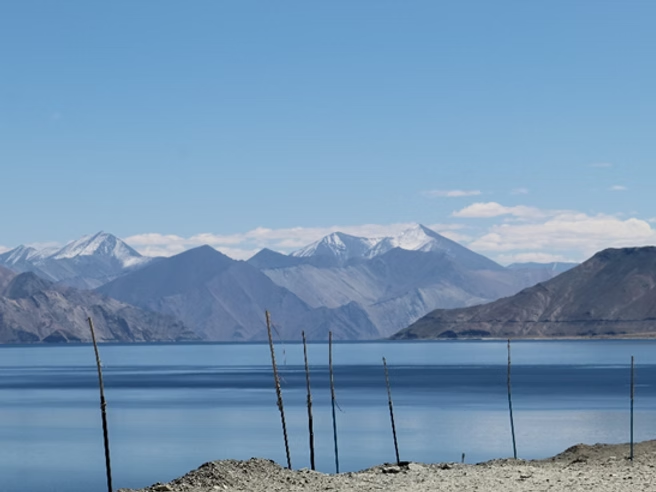
The mystic region of Ladakh, which is found in India’s far north, is renowned for its unearthly scenery and distinctive culture. Towering peaks, desolate mountains, and pristine lakes surround the area, making it the ideal vacation spot for outdoor enthusiasts and nature lovers. We’ll examine Ladakh and its natural beauty in more detail in this blog. Welcome to Ladakh, a place of breathtaking natural beauty and magical vistas that will captivate you. Ladakh, a region high in the Himalayas, is a haven for those who value nature, adventure, and spirituality. Let’s go off on a journey to explore Ladakh’s alluring beauty and learn more about this enchanted region. Himalayan Landscapes Ladakh’s breathtaking Himalayan scenery is one of its defining characteristics. Towering peaks, some of which are over 7,000 metres high, encircle the area and provide panoramic views and breath-taking vistas. Trekking through the mountainous terrain while admiring the breathtaking surroundings is enjoyable for visitors. The Markha Valley Trek, the Stok Kangri Trek, and the Chadar Trek are a few of the well-liked trekking routes in Ladakh. Ladakh is well known for its imposing mountains, which are both untamed and spectacular. You are enticed to discover the Himalayas’ magnificence by their snow-capped peaks, which form a breathtaking backdrop. Take a leisurely drive along the Leh-Manali Highway or travel to the isolated Nubra Valley, which is encircled by mighty mountains. Capture stunning views and enjoy the tranquilly of the highland setting. Credit: Unsplash Monasteries and Cultural Experiences Ladakh is also home to a number of historic monasteries that provide a window into the area’s distinct culture and traditions. These monasteries, which are positioned atop the mountains, provide breathtaking vistas and a spiritual atmosphere. The Hemis Monastery, the Alchi Monastery, and the Thiksey Monastery are just a few of the monasteries that can be visited. Additionally, the area is well-known for its energetic events, such as the Hemis Festival, which provide a distinctive cultural experience. There are numerous historic monasteries in Ladakh that radiate peace and serenity. Some of the most revered monastic complexes include Hemis Monastery, Thiksey Monastery, and Diskit Monastery, where you may observe monks chanting prayers and take in the serene ambiance. Discover Ladakh’s rich Buddhist legacy by admiring the exquisite murals, gilded sculptures, and antiquated texts that adorn the monasteries. Ladakh’s beautiful culture is an essential component of that beauty. Discover traditional artefacts, handcrafted items, and vibrant textiles in Leh’s local marketplaces. Experience performances of traditional folk dances and music that highlight the area’s rich cultural heritage. Engage in conversation with the welcoming inhabitants, indulge in regional specialties like momos and thukpa, and experience the welcoming hospitality of Ladakh. Credit: Unsplash Offbeat Destinations Ladakh is home to a number of unique locations that conventional tourist has yet to explore. For the adventurous traveller, these places provide a distinct and undeveloped experience. The Zanskar Valley, the Nubra Valley, and the Tso Moriri Lake are just a few of these unusual locations. Explore these locations to experience the tranquilly and natural beauty of the area. Pangong Tso, a dazzling lake that spans the boundary between India and Tibet, is a sight to behold. Be prepared to be mesmerised by its ethereal beauty. Visitors are in awe of the bizarre scene created by the clear blue seas and barren mountains. Spend a night camping beside a lake and take in the lake’s ever-changing colours as the sun rises and sets, illuminating the surrounding area. Explore the captivating Nubra Valley, a desert-like area hidden between imposing mountains, on an excursion. Enter a world of breathtaking sand dunes and historic monasteries by driving via the well-known Khardung La Pass, one of the highest motorable routes in the world. Enjoy a one-of-a-kind experience by riding Bactrian camels, which are distinguished by their double humps, over the immense Hunder Desert. Credit: Unsplash Adventure Activities Adventure sports like mountain biking, rafting, and paragliding are ideal in Ladakh. Mountain riding in the area is an exhilarating and exciting experience thanks to the region’s challenging terrain and high elevation. Additionally, tourists can take part in the demanding and thrilling activity of rafting in the Zanskar and Indus Rivers. Another well-liked adventure activity in Ladakh is paragliding, which provides a distinctive viewpoint of the area’s breathtaking scenery. For thrill seekers, Ladakh has a tonne of extreme things to choose from. Explore famous locations like Markha Valley, Zanskar, and Stok Kangri on exhilarating treks. On the Indus and Zanskar rivers, enjoy whitewater rafting, or try mountain biking on the difficult terrain. The rough terrain of Ladakh offers many options for rock climbing, paragliding, and star-gazing while camping. Ladakh is a place that will inspire you and make a lasting impression on your soul thanks to its mystic landscapes, rich culture, and spectacular beauty. Plan your trip to this Himalayan beauty and get lost in Ladakh’s magic, where the majesty of nature meets spiritual tranquilly. In conclusion, Ladakh is a mysterious area that provides tourists with a distinctive and rejuvenating experience. The area is ideal for a great holiday because of its Himalayan landscapes, monasteries and cultural experiences, unusual locations, adventurous activities, and local cuisine. So be ready to pack your bags and travel to Ladakh to explore its natural beauty and make lifelong memories. Credit: Unsplash

